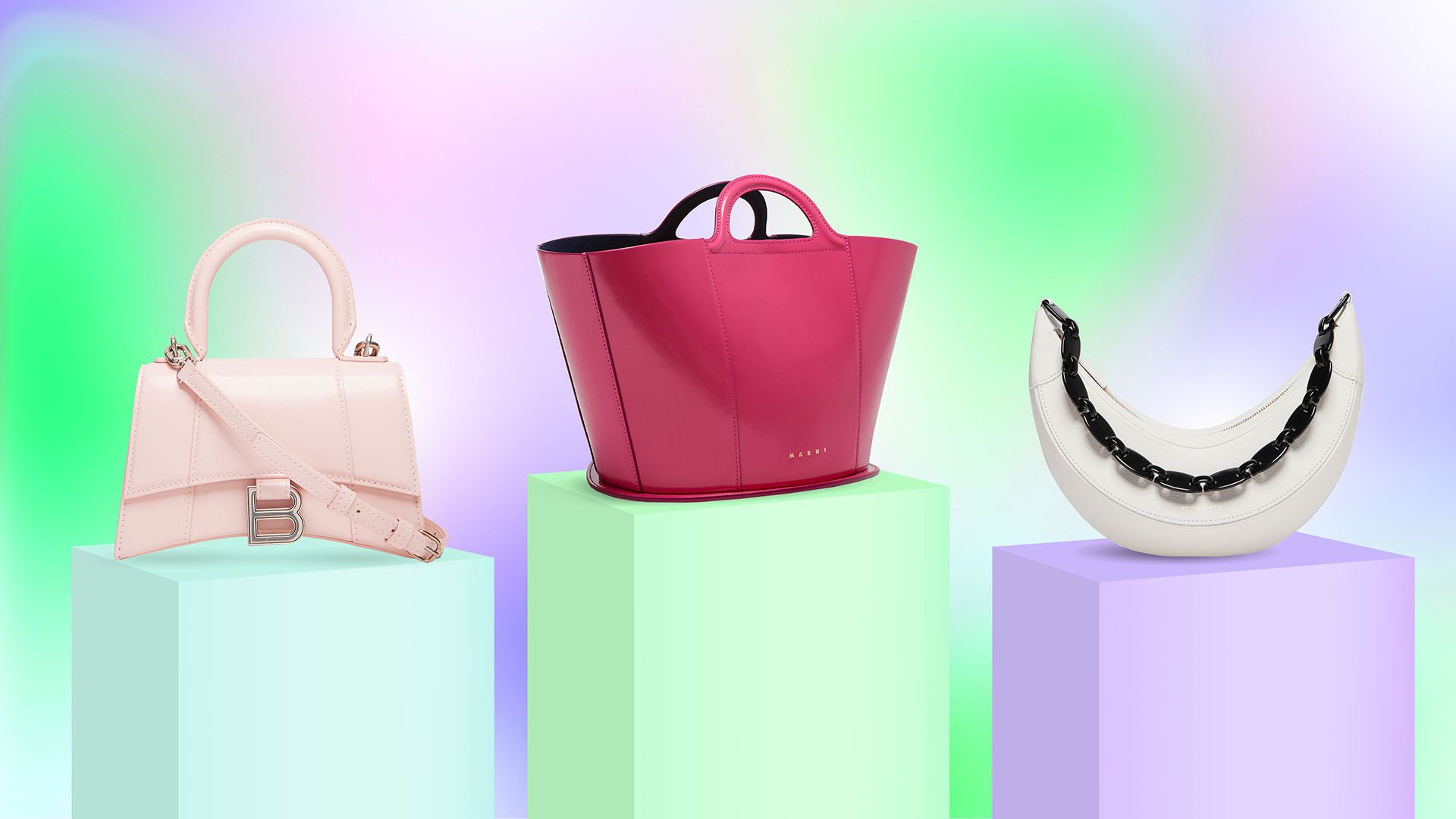-
The Revival Of The Bag

Bags, from left to right: Hourglass handbag Balenciaga, Tropicalia tote bag Marni, Banana bag Rejina Pyo.
The genderless bag
While there's no shortage of prestigious houses unveiling collections both masculine and feminine during the same show, the liberation of gender is gaining ground in the world of garments. Just like the smoking jacket in its day, though in the opposite direction, the handbag has become the genderless piece par excellence, especially given that men love a practical object just as much as women. Their popularity has taken off, and it means that men are no longer limited to backpacks or briefcases. From Margiela to Gucci, bags are attracting a more masculine clientele than ever. As evidence of this fluidity, handbags are equally appropriate for all genders. Plus, they can be worn exactly the same way — on the shoulder or perched on the forearm — and in so doing give a sassy wink to old norms. The evolution also caught the attention of young New York-based labels like Telfar, as well as at Bottega Veneta and Prada, with models like The Pouch and the Galleria.
The utilitarian bag
With the renewal of 90s fashion over the last few years, the fanny pack — renamed the "belt bag" — has taken luxury houses by storm. Fastened around the waist or cross-body style, it inspired creators like Balenciaga's Demna Gvasalia, Burberry's Riccardo Tisci, and Alessandro Michele at Gucci. Characterized by its high practicality, the belt bag pushed designers to reflect more deeply upon different fashions to the point that an entirely new style was born. Featuring plenty of pockets at Alexander Wang and Givenchy,
the belt bag goes minimal for Côte & Ciel's' Adda model, or incognito in the form of a knotted sweater. As an adjustable harness for 1017 Alyx 9SM, it can be worn almost like an article of clothing, blurring the boundary between garments and bags.
Left: Galleria bag Prada. Right: Iwen handbag Sabry Marouf.
The miniature bag
Star of Jacquemus' 2019-2020 Autumn-Winter collection — thanks to or in spite of its 5.3x4.3cm dimensions — the Chiquito mini-bag kicked off a craze for lilliputian purses. Quickly becoming a meme on Instagram due to its size — no more than a pair of AirPods fit — the Little Chiquito became such a runaway hit that it drove houses like Gucci and Prada to start producing miniatures of their own iconic models. From Balenciaga's Hourglass model in size XS to Manu Atelier's microscopic Demi and Cylinder styles, not to mention Burberry, Vivienne Westwood, and Aspinal of London, the mini-bag encourages minimalism in an age where smartphones serve as credit cards. A testament to the tongue-in-cheek mischief of certain creators and their taste for the absurd, the micro-purse pokes ironic fun at an object whose goal is, lest we forget, functionality.
The bejeweled bag
The slimming-down of certain handbags demonstrated that rules were made to be broken, especially when we wear them. Light and easy to carry, bags have even started being strung around the neck and worn as necklaces, such as in Jacquemus' rounded and squared Pitchou models, keeping the wearer's hands free. In a different register and independent of size, other brands have been polishing the links between jewelry and handbags by using materials largely reserved for bracelets, necklaces, and earrings. Founded by British creator Hannah Weiland, the Shrimps label is known for their colorful faux-fur coats, and offers understated handbags hewn in pale or saturated mother-of-pearl. It lends a touch of fantasy to the world of the purse, all with an eye to sustainable climate solutions. Indeed, thanks to their partnership with One Tree Planted, the brand plants a tree for each piece purchased.
Left: Mini belt bag Alexander Wang. Right: Le Gadjo wallet Jacquemus.
The oversized bag
In contrast to how the mini-bag inspired the bejeweled creations of late, the design world's riff on volume and proportions also marked the arrival of bags so big they looked like something out of Mary Poppins. Indeed, the season before his bite-sized bags burst onto the scene, in Spring-Summer 2019 Jacquemus' Simon Porte introduced a gigantic woven version. To balance the "Petit Chiquito," the designer returned the following season with a brick-red canvas bag of gargantuan dimensions. That same season, for his first collection with
Lanvin, designer Bruno Sialelli tried his hand at extreme dimensions, also adopted in 2016 by Balenciaga's Demna Gvasalia and the "Bazar" models, two enormous bags in Liberty print. Taken up by Daniel Lee at Bottega Veneta, the Acro model also takes on the maxi-trend, a play on scale that still has surprises in store.
The eco-responsible bag
Respect for the environment is at the heart of many designer's central concerns, posing constraints to which, the fashion industry must adapt. The increased awareness that the planet must be preserved is having important impacts in the world of clothing as well as accessories, pushing designers to innovate and employ new materials that align with sustainable development standards. At Burberry, eco-friendly fabrics that require less water and generate less CO2 to produce have been developed for bags, belts, and other leather goods. Founded in 2012 by Jasmin Larian Hekmat, Cult Gaia
and a host of other labels have placed their bets on natural materials like rattan and bamboo.
Left: Egg bag Simone Rocha. Right: Eos clutch bag Cult Gaia.
In the hands of unstoppable creatives, the handbag can get so experimental that it becomes a work of art. Ahmed Sabry and Daki Marouf, designers at Saby Marouf, demonstrate this with their sculptural creations inspired by Ancient Egypt, using rigid materials like Plexiglass to imitate minerals like alabaster, lapis lazuli, and rose quartz. Alongside them stand Cult Gaia's "Eos" model, with its delicate marbling, and Simone Rocha's "Egg," a reminder of the Irish creator's obsession with mother-of-pearl, reproduced here in large-scale acrylic models.


